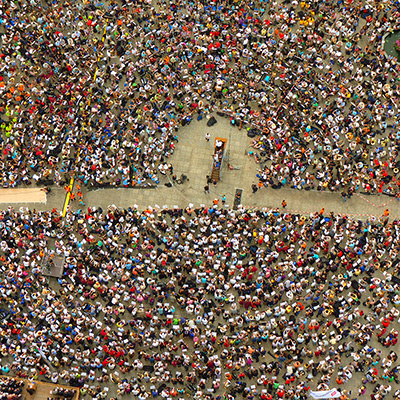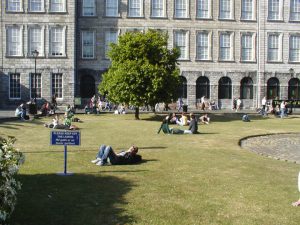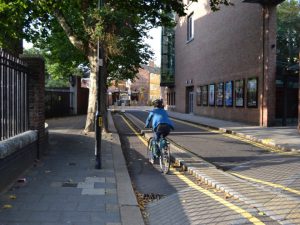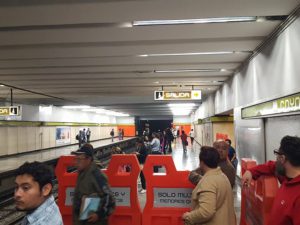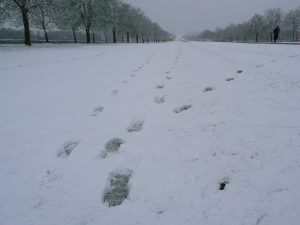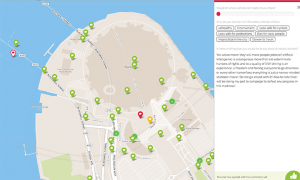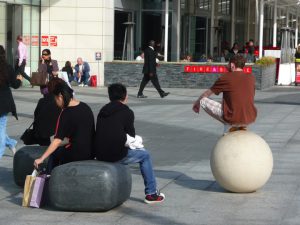Thank you to our guests over the Spring 2018 semester: Madeleine Elish (Data & Society), Simone Rebaudengo (Automato.farm), Deepa Butoliya (Carnegie Mellon, soon to be University of Michigan), Emily LaRosa (Carnegie Mellon), Professor David Danks (Carnegie Mellon), and Bruce Sterling and Jasmina Tešanović (Casa Jasmina).
Environments Studio IV is about design, behavior, and people’s understanding, in physical, digital, and hybrid environments, with a specific focus on intelligence of different kinds, from social interaction to artificial intelligence. The course comprises practical projects and workshops focused on investigating, understanding, and materializing intelligence and other invisible and intangible qualitative phenomena and relationships, through new forms of probe, display, and interface. We are re-interpreting the formal course title, ‘Designing Environments for Social Systems’, as being about engaging with intelligence in its many forms.
- Tuesdays and Thursdays, Margaret Morrison Carnegie Hall 214, 1.30–4.20pm, January 16th to May 3rd, 2018
- Instructor: Dr Dan Lockton (danlockton@cmu.edu) — book a meeting — plus guests
This syllabus will be updated over the course of the semester. But the basic plan is that we will cover three units, each of which will result in a project:
| Weeks 1–3: Jan 16–Jan 30 | Unit 1: Design, behavior and social interaction | How the design of environments, and features within them, affects people’s thinking, behavior and interaction. Other minds as part of context. Project: Probing how design, intelligence and behavior interact in a particular situation (20% of grade). |
|---|---|---|
| Weeks 3–8: Feb 1–Mar 6 | Unit 2: Speculating intelligence |
Using speculative design and design fiction to investigate directions that new approaches to intelligence(s) in environments might lead, and some of the consequences. Project: Creating a piece of speculative design (object, website, movie, etc) which tells a story (30% of grade). |
| Weeks 8–16: March 8–May 3 | Unit 3: Where are the humans in AI? |
[Details to follow]. Project: [details to follow] (40% of grade). |
Note that there will be no class on March 13th, March 15th or April 19th, due to Spring Break and Spring Carnival. As the projects progress, the class is intended to be studio time for you to work on your projects, which may sometimes mean that you don’t actually have to be present (e.g. if you’re doing field research, using workshops, etc). Please let me know though. There are a few sessions where I will be away at conferences, but I will arrange either for a guest or for a pre-planned activity for these sessions. 10% of your grade is for engagement in class.
Unit 1: Design, behavior and social interaction (Weeks 1–3: January 16th to 30th)
In this short introductory unit, we will look at the ways in which the design of environments, and features within them, affects people’s thinking, behavior and interaction with each other. Design influences what people do, but often the ‘links’ are invisible or only apparent by their effects. Or, we notice them in passing, but do not take time to reflect on them or draw parallels across situations. As designers pioneering new approaches to creating environments for human experience, cultivating a kind of ‘hypersensitivity’ to noticing—and learning from—the ways in which design, intelligence and behavior interact can be part of developing the attention to detail which will serve you well professionally. Parts of this unit draw on Engaged Urban Research Methods, a course that Flora Bowden and I developed and have taught for two years with Don Ostdiek for Rice University’s summer program in Copenhagen.
- An unintended use: a fire extinguisher used to prop open an office door (Brunel University, London)
- ‘Disobedience’, Trinity College Dublin: ‘Please keep off the lawns’
- A constraint, Islington, London: physical separation of cycle lane from the main carriageway of a road
- A potential point of confusion for users unfamiliar with the situation: a women-and-children only platform area on the Mexico City metro
We start with quick observation exercises aimed at developing (or refreshing) a capacity for noticing, for paying attention to the ways in which people and environments affect each other. First, we will look around campus for instances of points of confusion, unintended uses, constraints, and disobedience in physical environment settings, and discuss how these effects manifest in different ways—what can you find?
We will watch part of William H. Whyte’s classic documentary The Social Life of Small Urban Spaces (1979) to explore some of the approaches to thinking about, and studying practically, how the design of environments influences people’s actions, and read a bit about thigmotaxis in architecture and how psychological phenomena such as this can be investigated. We will do some observation in more detail around campus, eliciting and characterizing the patterns that emerge from different people’s interaction with environments over time, using principles from John Zeisel’s Inquiry by Design, adapting them for digital contexts where appropriate. This could be, for example, looking at how people navigate a space or how people use a piece of technology within a physical environment, and the diversity of interactions that happen.
The Social Life of Small Urban Spaces by William H. Whyte (on the Internet Archive)
Assignment 1: Design, behavior and social interaction
Your project brief for Unit 1 is around observation (and a way to record your observations)—designing and using a ‘probe’ rather than creating a solution to a problem:
—Choose a situation where ‘design’ seems to be affecting how people think and act in an environment (physical or digital)
—Find a way of observing and studying what’s going on—what patterns exist? In what different ways are people’s thinking and behavior affected?
—Visualize (or otherwise communicate) what you find. It might be written, video, drawing, animation, a model…
—(optional: suggest ways things could be different, or better, if you feel they could be improved)
—Keep a blog of your process (photos, sketches, notes)
—Be ready to present your project in class on Tuesday January 30th
This is an individual project: you can collaborate where you need to, but make sure you each do your own investigation. You might look at ‘mass’ behaviors quantified or visualized (e.g. people’s paths around an obstacle) or something more qualitative (e.g. people’s sentiments in a particular environment, or using a particular piece of technology). You might want to study what’s happening using your own observation in-person, record it over time, or develop a way for (traces of) the phenomenon to be somehow tracked or logged directly. Maybe people’s thinking or behavior is revealed through annotations that others have made—signs or notes explaining what to do. How do ‘real-world’ observation methods translate to a digital context, and vice versa?
Deliverables
- presentation, Jan 30th (please try to keep to 5 minutes)
- a blog post of your process (please email to danlockton@cmu.edu)
- please also send the presentation or other materials you have produced (or put them on Google Drive)
- Pedestrian flow through a German rail station, drawn from video (from research by Maria Davidich and Gerta Köster
- Footprints in the snow provide a revealed trace of people’s paths
- The way this map at a zoo has been worn by people’s fingers around the “You Are Here” marker suggests they may have been tracing paths to take and areas to see.
- Candy Chang’s I Wish This Was project involved placing “stickers on vacant buildings across New Orleans to invite residents to easily share their hopes for these spaces”
- Arrows given to office workers as part of the CarbonCulture at DECC project so they could annotate their space with comments and questions about energy use.
- Commonplace provides commentable maps so members of the public can add their ideas or reactions in situ. Here the comments are about a driverless car trial in London.
Alongside the project, we’ll be looking at other aspects of design and behavior in environments. We’ll delve a bit into explicit design for behavior change techniques, particular those involving the design of features in indoor and outdoor built environments, those which have parallels across physical and digital contexts, and those where bringing contextual information into places it wouldn’t otherwise be, can change the experience people have and the decisions they make. We will also explore some ideas from my own forthcoming Design with Intent book. Some concepts here include the ideas of enabling, motivating or constraining behavior, Herbert Simon’s ‘scissors’ metaphor for the interplay of context and cognition, the idea of stigmergy being considered within design, and questions around the extent to which people’s behavior can ever be ‘planned’.
- Enabling: Wheelchair-accessible beach area, Nice, France
- Redesigning the kitchen: design by Ernő Goldfinger, 1944
- Constraining behavior: broken glass cemented into a wall
- Pseudo-seating objects at a Westfield mall in Shepherd’s Bush, London
- Entrance for “Special Girls” at former school, Zaha Hadid Architects’ headquarters, London
- Putting contextual information into the environment: footprints to follow on a busy airport concourse
- Putting contextual information into the environment: Pittsburgh warns against dumping into drains
- Putting contextual information into the environment: morePlatz’s Baugespann “visualizes future urban developments in scale 1:1 by an inflated balloon-structure”
We will watch/read parts of Stewart Brand’s How Buildings Learn, particularly to think about the longer time dimension of people’s interaction with environments, Frank Duffy’s concept of shearing layers, Brand’s later concept of pace layers, and subsequent adaptations of the idea in relation to hybrid physical/digital environments. We will also think a bit about the practice of observation, noticing and deconstruction of people’s actions in different ways, such as exhaustive detail (Georges Perec, Nicholson Baker) and considering rhythms (Henri Lefebvre), and the diversity of ways in which a place such as a city can be experienced and interpreted by different people (Jane Jacobs, Geoff Manaugh). We will briefly consider how intentions are often read into observed behavior, watching Fritz Heider and Marianne Simmel’s classic video from “An Experimental Study of Apparent Behavior” and discussing the fundamental attribution error.
Unit 1 Readings
Extracts from:
- Ann Sussman and Justin B Hollander, 2015, Cognitive Architecture
- Jane Jacobs, 1961, The Death and Life of Great American Cities
- John Zeisel, 1984, Inquiry by Design: Tools for Environment-Behavior Research
- Henri Lefebvre, 2004 (1992), Rhythmanalysis
- Nicholson Baker, 1988, The Mezzanine
- Georges Perec, 2010 (1975), An Attempt At Exhausting A Place in Paris
- Geoff Manaugh, 2016, A Burglar’s Guide to the City
- Stewart Brand, 1994, How Buildings Learn: What Happens After They’re Built
- Stewart Brand, 1999, The Clock of the Long Now: Time and Responsibility
- William H. Whyte, 1980, The Social Life of Small Urban Spaces
- Fritz Heider and Marianne Simmel, 1944, ‘An Experimental Study of Apparent Behavior’
- Deborah Du Nann Winter and Susan M Koger, 2004. The Psychology of Environmental Problems, 2nd edition
- Dan Lockton, 2012, ‘Simon’s Scissors and Ecological Psychology in Design for Behaviour Change’ (link)
- Dan Lockton, 2011, ‘Architecture, urbanism, design and behaviour: a brief review’ (link)
Files will be on Google Drive.
Unit 2: Speculative Design and Intelligence (Weeks 3–8: February 1st to March 6th)
Your project brief for Unit 2 is around using speculative design and design fiction to investigate directions that new approaches to intelligence(s) in environments might lead, and some of the consequences.
You are going to be creating a piece of speculative design (an object, an experience, a website, a movie—or lots of other potential formats that we’ll talk about) which tells a story about not just things, but their context, and how people interact with them. In a sense this is about the intersection and interaction of different forms of intelligence—human intelligence (perhaps even ingenuity) and artificial intelligence, but potentially blurring the boundaries somewhat, and recognizing the complexity of each of these.
The approach we’re taking is to extrapolate from ‘weak signals’ in the present—phenomena or trends that you notice or find interesting—and thinking through some of the possible consequences, and how those might affect, in turn, what is designed and how people live with and experience the situations.
This project can be done either individually or in pairs (which might enable more ambitious projects). If you work in a pair, make sure to keep a record of how you each contribute.
Deliverables
Each project may take different turns and directions, so the deliverables will vary—and we can talk about that together as you work on your project but in general, the aim is that on March 6th we can have presentations / a small exhibition of the projects. So your deliverables should include something you can show, or that people can ‘experience’ or interact with in some way, and a record (a short write-up or blog post) of your process, including sketches and notes.
The crowd image used for the link to this page on the homepage is a strike or protest, by LoggaWiggler, CC0-licensed.
Unit 3: Where are the humans in AI?
Introduction
As artificial intelligence starts to pervade our everyday lives, it will happen gradually: the products and services we use, and decisions that are made without our knowing, are likely to incorporate various forms of machine learning and data-driven algorithmic processes whether we realize it or not; indeed, they already are. We’ll be dealing with multiple intelligences, both human and machines, and the boundaries between them may not be especially clear.
But much AI has a human component—it’s being trained on us! We, the ‘users’, are part of the system. Or, it may involve even greater levels of human labor behind the scenes, either hidden intentionally, or marginalized. Our futures do not involve just encountering AI, but ourselves becoming part of a system of intelligences, an environment of human- and non-human cognition and metacognition, differently complex to the social environments we have become used to, with rules and biases and hidden power structures, some familiar, some new. We are going to have to think about things that think about how we think.
Designers have the ability here to surface issues and provoke discussion in an engaging and accessible manner, through creating experiential ways for people to encounter and explore the dimensions of these new relationships. Applying the perhaps familiar language of consumer product and interaction design can help reframe debates and enable more nuanced understandings of emerging technologies and how they might affect our lives. But designers also have a huge responsibility to approach their own work in these areas with a critically informed stance; and design educators have a responsibility to foster and provide support for the development of an ethical form of practice.
Collaboratively produced reading list
The brief asks you to respond to the question:
Where are the humans in artificial intelligence?
You can address this question from different perspectives, potentially including:
—giving us an experiential, design fiction preview of a possible near-future home / work / leisure environment, including the consequences, possibilities, and frictions of interactions between multiple intelligences, human and non-human
—investigating, materializing, and making engageable-with the human side of AI, from hidden labor, to the data flows in the systems around us, to how humans are modeled in the systems being developed
—proposing new approaches or speculative visions of how human/non-human intelligence might evolve in the context of a particular digital, physical or hybrid environment
The projects—which may be done individually or in groups—should be informed by interdisciplinary insights, bringing both technological and humanities knowledge to bear on the issues, and the development and research process documented via a blog or other format. The aim is to produce a set of projects which can be exhibited together or separately and which are experiential or at least interactive for visitors; the final course presentation will be in the form of an exhibition in Pittsburgh, but the projects should be produced in a form which enables subsequent exhibition elsewhere.
Ideally we will produce a catalog including elements of your process documentation, and depending on the topics involved, there is the potential for wider dissemination in academic and more general interest articles, and entry in design competitions.

